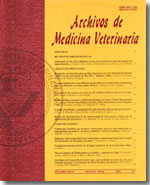Anal atresia in dogs and cats: the scope from three clinical cases
Main Article Content
Abstract
Anal atresia is defined as the lack of a complete communication between rectum and the anus, it is the most common anorectal malformation and has been observed mainly in dogs. It has been associated to alterations of anogenital differentiation of the cloaca in the embryo, however, the exact mechanisms remain unclear. Different criteria have been proposed in the literature to classify anal atresia. This study shows the diagnosis, treatment and outcome of three cases (two dogs and one cat) with anal atresia. The frequency of this malformation in our hospital is reported as well as a discussion of the theories of the processes involved in the development of anal atresia, and a revised classification for this pathology according to embryo anatomy and development is proposed.

